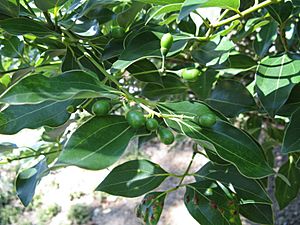Japanese cinnamon facts for kids
Quick facts for kids Japanese cinnamon |
|
|---|---|
 |
|
| Conservation status | |
| Scientific classification | |
| Genus: |
Cinnamomum
|
| Species: |
tenuifolium
|
| Synonyms | |
|
|
Meet the Japanese cinnamon tree! Its scientific name is Cinnamomum tenuifolium. This tree is an evergreen, meaning it stays green all year long, just like a Christmas tree. It's a small to medium-sized tree, growing up to about 15 meters (that's about 50 feet) tall. You can find it growing naturally in countries like Japan, Korea, Taiwan, and parts of eastern China. In China, this tree is special enough to be protected by the government.
Where Does Japanese Cinnamon Grow?
The Japanese cinnamon tree grows in many places. You can find it in about 40 to 50 different spots across southern Japan, southern Korea, Taiwan, and several provinces in eastern China. These trees love to live in lowland evergreen forests. They usually grow at elevations between 300 to 1,000 meters high.
Why Is This Tree Important?
The Japanese cinnamon tree faces some challenges. Its natural home is shrinking because forests are being cut down. People sometimes clear forests to make space for farms or tree plantations. This means there are fewer places for these trees to live. Even though its habitat is getting smaller, experts say it's not in immediate danger of disappearing. This is because it still grows across a very wide area and in many different locations.
What Is Japanese Cinnamon Used For?
People use the Japanese cinnamon tree for different things.
- Wood: The wood from this tree is strong and lasts a long time. Because of this, it's often used to make furniture and to help build houses.
- Oils and Scents: The bark and leafy branches of the tree contain a special oil. This oil smells nice and is used to make perfumes.
- Soap: The seeds of the fruit have oil and fat inside them. These parts can be used to make soap!


